Pinkerton: The General Motors Strike Will Test Which Party Will Work for Workers in 2020
What if They Had a Strike and Nobody Noticed—Until They Did?
Not so long ago, a United Auto Workers strike against General Motors was a big deal. Of course, not so long ago, General Motors was a big company—in fact, the biggest company in not only the U.S., but in the whole wide world.
Times change, and now the GM strike, which began on September 15, is just a footnote in the news. Or, actually, we should say, it was just small beer, until both Elizabeth Warren and Bernie Sanders announced that they would visit the Michigan picket line. Maybe soon, another dozen or so Democrat presidential candidates will show up, too, along with the usual traveling circus of roving reporters, talking heads, and publicity-seeking celebrities.
Yes, times change—and they never stop changing.
Yet even if the GM strike is now firmly in the news, the fact remains that GM today is just a shadow of what it once was. It’s only the 13th-largest company in the U.S. by revenues and the 32nd-largest in the world. And if one measures GM by market capitalization—that is, the total value of its stock—it’s even further back in the pack; its market cap is $54 billion, whereas top-ranked Microsoft is worth $1.06 trillion, or 20 times as much.
For its part, the UAW, too, has shrunk dramatically; its membership has declined by nearly three-fourths over the last four decades, from 1.5 million in 1979 to 400,000 today.
By now, these sorts of statistics—the rise of tech, the decline of manufacturing, including manufacturing employment—have become familiar. Yet still, as a nation, we haven’t yet figured out how to make sure workers get a fair piece of the pie. How are people—with or without unions—going to make a living in the 21st century?
Perhaps we can gain perspective on this question by learning more about how leaders thought about jobs and economic justice in the 20th century. Yes, times and technology have changed, and yet human beings are still human beings. And as American citizens, they have political rights and legitimate needs—and these, as we shall see, have been sorely neglected in recent decades.
When Workers Were Strong—Maybe Too Strong
Let’s go back to November 21, 1945, when the UAW struck GM. That strike was a front-page big deal, with vast national repercussions. For context, we can recall that this strike came just three months after the end of World War II; in the new post-war era, both business and labor, unleashed from most wartime controls, were eager to get back to peacetime manufacturing and working.
So if GM wanted to sell more cars, its workers wanted more pay; specifically, the union wanted a 30 percent raise. GM said “no,” and the strike was on; some 320,000 employees hit the picket lines. (We might note that in those days, the GM strikers represented .56 percent of the nation’s total employment. We can pause to observe that more than half of one percent for just one firm is a lot; by comparison in 2019, the GM strike involves only 48,000 workers, or .003 percent—less than a thirtieth of one percent—of America’s employed today.)
In March 1946, four months after the labor action began, the two sides reached a settlement; GM workers got a 17.5 percent raise.
Yet the GM strike was just an overture; 1945-46 saw a nationwide wave of strikes as electrical workers, meatpackers, steel workers, oil workers, railroad engineers, theatrical craftsmen—4.3 million workers total—went off the job. That was roughly eight percent of the workforce.
Needless to say, all these strikes put a burden on the economy, as well as on the social order. In particular, in those days, as the first chill winds of the Cold War were being felt, J. Edgar Hoover’s FBI had well-founded concerns about communist influence—even outright pro-Soviet activity—within some unions. In the meantime, in addition, evidence abounded of mob influence and hooliganism within some unions.
So the challenge to the nation was serious—that is, balancing the rights of workers alongside the overall public interest in law-abiding prosperity.
This need to find the proper balance meant re-examining a key piece of legislation that had been passed in the New Deal decade of the 1930s, namely, the National Labor Relations Act, better known as the Wagner Act.
The Wagner Act was called the “Magna Carta for labor” for a reason; just as the Magna Carta (Great Charter) back in 1215 had guaranteed rights for Englishman, so, too, did the Wagner Act guarantee rights for labor, including:
The exercise by workers of full freedom of association, self-organization, and designation of representatives of their own choosing, for the purpose of negotiating the terms and conditions of their employment or other mutual aid or protection.
That is, collective bargaining. Unions.
It’s interesting to recall the breadth of support for the Wagner Act at the time of its passage; back in ’35, in the middle of the Depression, majorities in both parties agreed that something had to be done to empower workers. Thus the U.S. Senate approved the measure by a vote of 63 to 12, with a dozen Republicans joining in support, while the House passed the bill without even bothering with a recorded vote. On July 5, 1935, President Franklin D. Roosevelt signed it into law, describing it “to be necessary as an act of both common justice and economic advance.”
The Wagner Act was broadly popular because it was based on an obvious point: To achieve a fair bargain, both sides in a negotiation need to have bargaining power.
To put that another way, if Big Business was the new economic reality, then labor needed to be big, too. After all, if labor wasn’t strong enough to stand up to business, then business would rule, perhaps in the manner of European fascism.
In other words, as is the risk with any one-sided regime, a lopsided power equation in favor of business could lead to tyranny. And that, in turn, could produce a backlash, some sort of violent revolt. Indeed, it’s worth recalling that in 1935, the Bolshevik Revolution in Russia was a recent memory; no right-thinking American wanted to see the red tide coming here.
So the Wagner Act was, in reality, a moderate compromise, aimed at fending off radicalism from either the right or the left. Indeed, it echoed the checks and balances written into the Constitution; the whole idea was to guarantee that business would have to bargain with labor. The economist John Kenneth Galbraith would later describe the system as the interplay of “countervailing forces”: Big Business checked by Big Labor—and vice versa.
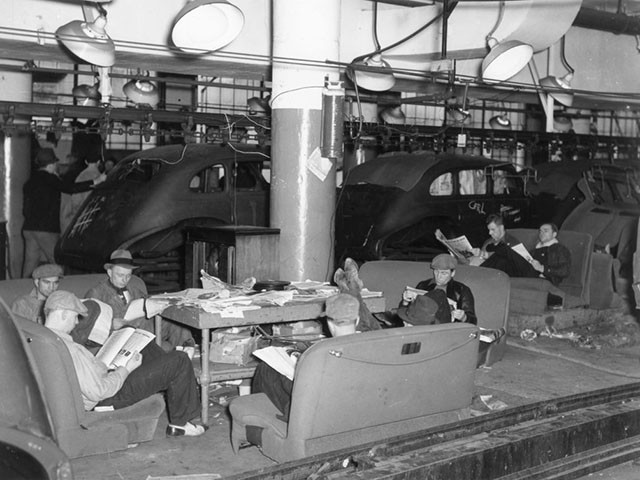
Members of the nascent United Auto Workers (UAW) union during a sit-down strike in the General Motors Fisher Body Plant in Flint, Michigan in 1937. (Sheldon Dick/Getty Images)
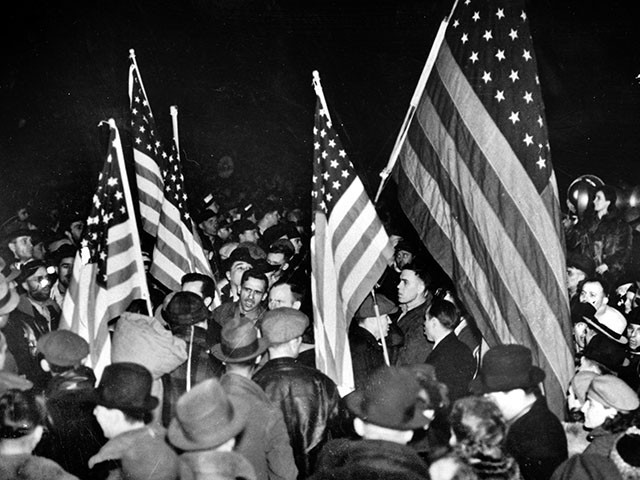
Autoworkers wave American flags at the General Motors Fisher body plant in Flint, Michigan, on February 12, 1937, during the famous Flint sit-down strike. (AP Photo)
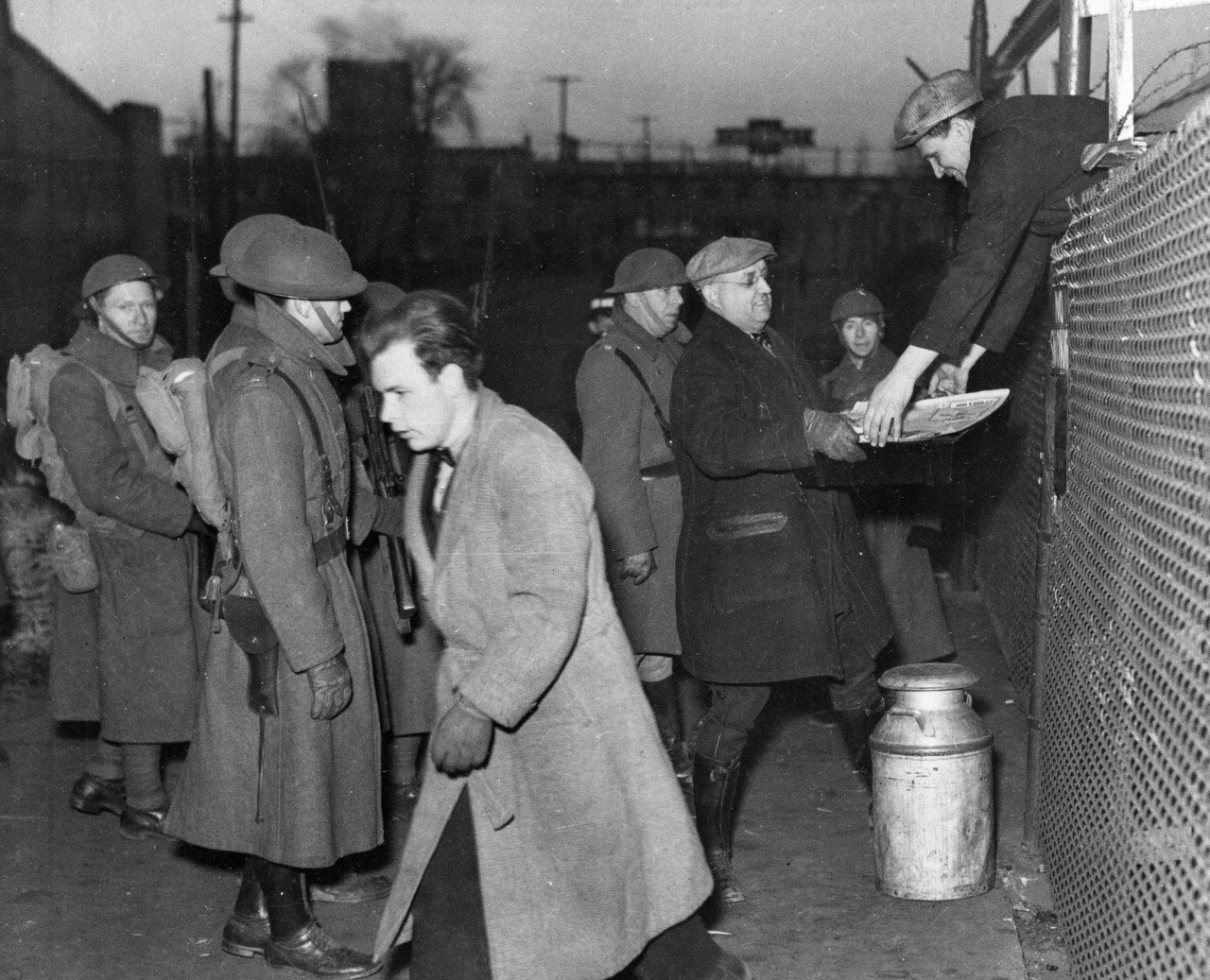
A General Motors’ sit-down striker reaches over a fence to receive a pan of food from a friend during the 43-day strike of auto workers at Flint, Michigan, in February 1937. Guarding the proceedings at gate 4 of the Chevrolet plant are members of the National Guard. (AP Photo)
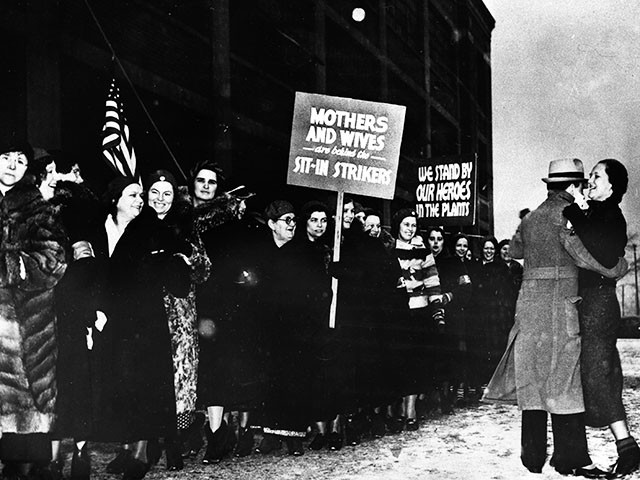
The wives, sisters, and sweethearts of the Flint sit-down strikers gathered to demonstrate in support of strike outside the General Motors plant in Flint, Michigan, on February 5, 1937. (AP Photo)
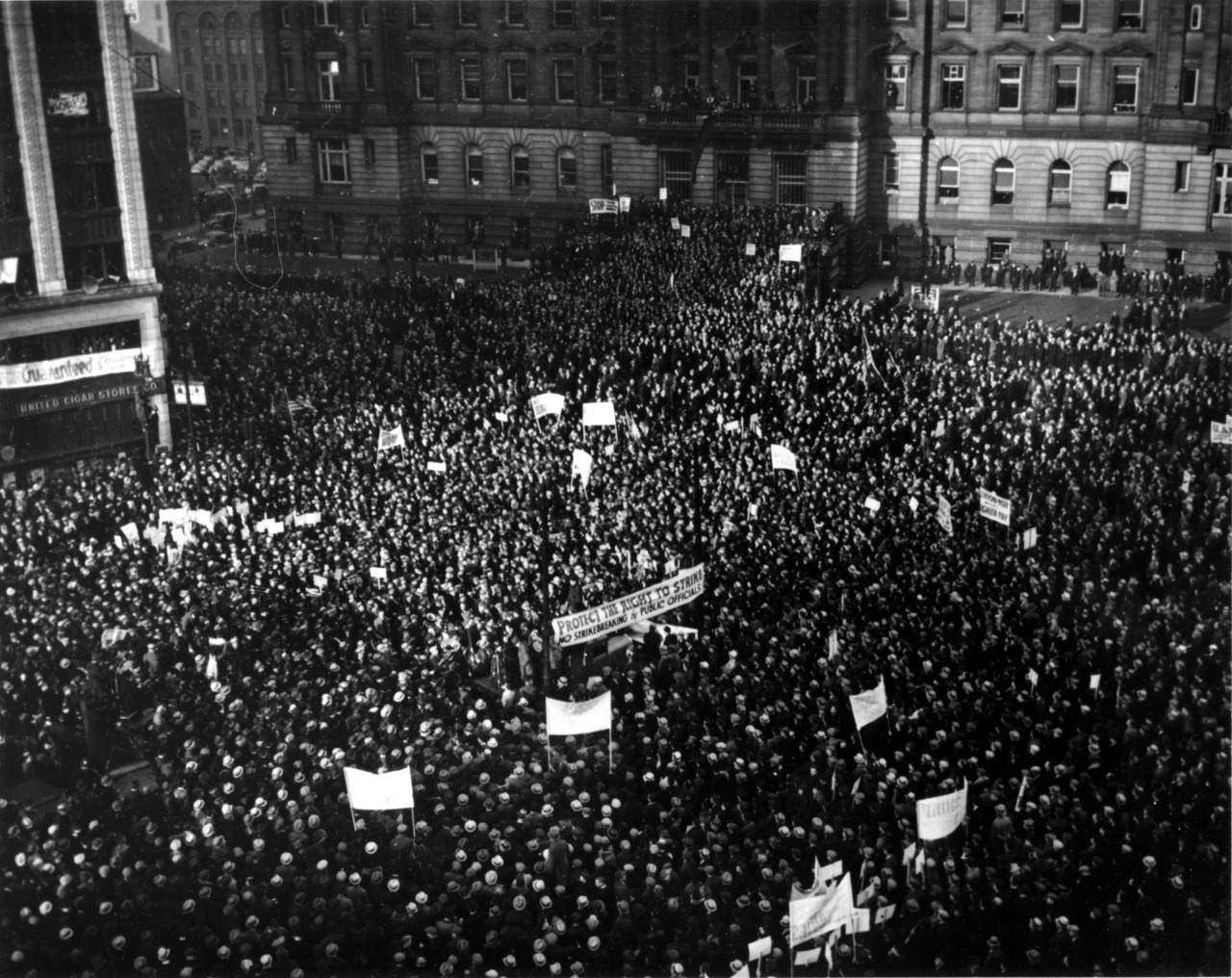
Thousands of demonstrators gather in Detroit’s Cadillac Square on March 24, 1937, to show support for the Flint sit-down strikers trying to unionize General Motors. (AP Photo)
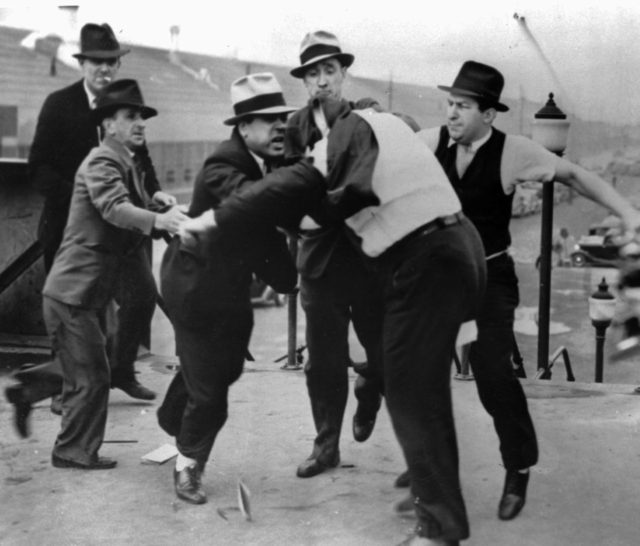
Richard Frankensteen, UAW organizational director, with coat pulled over his head, is pummeled by Ford Motor Company agents at the gate of the Ford River Rouge Complex in Dearborn, Michigan. Ford security personnel were countering the UAW’s efforts to organize employees at the factory complex in an event known as the Battle of the Overpass on May 26, 1937. (AP Photo)
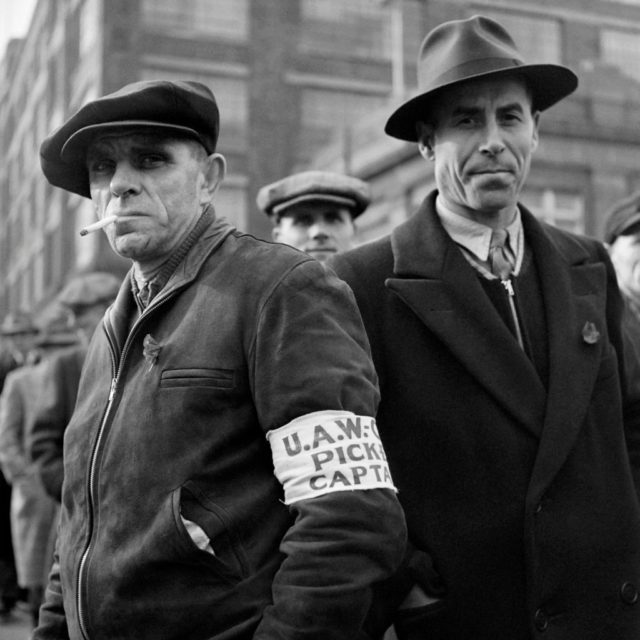
Workers on strike wearing a UAW armband at the Ford Motor Company plant in Detroit, Michigan, in April 1950. (AFP/Getty Images)
Harry Truman Confronts the Labor Crisis
As a senator in 1935, Harry Truman had voted for the Wagner Act, and yet now, as president in 1945, he saw that the reform needed reform; labor’s Magna Carta had given the unions too free a rein—and so it was time to rein them in.
In Year of Decisions, the first volume of his memoirs, Truman wrote, “By the autumn of 1945, the labor situation was assuming serious proportions … The increasing labor difficulties of the postwar period were the subject of many discussions with the Cabinet in meetings in October and November.”
This labor unrest was ironic, because, of course, Truman and the Democrats in charge of Congress were generally pro-labor. And yet as we all have discovered, even a good thing is often in need of tinkering—and if necessary, a full overhauling.
Being the energetic man that he was, Truman took action; he invited the leaders of labor and management—including the heads of the U.S. Chamber of Commerce, the National Association of Manufacturers, the American Federation of Labor, and the Congress of Industrial Organizations—to meet with him in Washington to “work out a new approach to toward solving the industrial crisis.”
We might pause over those last two words, “industrial crisis.” As Truman further wrote, “The country needed a national wage policy, effective mediation machinery, and other remedial legislation which would protect the rightful interests of labor, of management, and of the public.”
Mindful of these goals, Truman began to formulate a series of reforms to the Wagner Act, such as mandatory cooling off periods and a ban on secondary strikes. He was even willing, if need to be, to send in federal troops to operate trains and mines; Truman was pro-labor, yes, but he was pro-public interest, first.
On November 5, 1945, Truman addressed the assembled leaders of business and labor in the Labor Department’s main auditorium—a bit of signaling there. Yet still, in his speech, the president spoke bluntly to both sides: “Failure to produce any workable recommendations on how to avoid work stoppages would mean legislation by Congress.” In other words, if you guys in the private sector can’t figure this out, elected officials will have to step in.
Unfortunately, the negotiations proved to be just more confrontations; even as they were sitting in the same room together, under the watchful eye of Team Truman, business and labor leaders couldn’t agree on anything important.
Indeed, to Truman’s dismay, the single most difficult figure proved to be a labor man, John L. Lewis, president of the mighty United Mine Workers. In that period, Truman summoned Lewis to the White House on no less than six occasions, warning him that “precipitous strikes” could lead the opposition congressional Republicans pushing “punitive measures against labor.” Indeed, when the mine workers defied a federal court’s back-to-work order, Truman’s Justice Department hauled Lewis himself into court, finding him guilty of civil and criminal contempt.
Beyond his exasperation with Lewis, Truman was concerned that if he and his fellow Democrats couldn’t take labor to the higher ground of constructive compromise, the Republicans would take labor to the abyss of annihilation. That is, whereas Democrats wanted to reform the Wagner Act, many Republicans, grown more militant since the ’30s, were now seeking its outright repeal.
Truman was nothing if not vivid in a letter he wrote to another labor leader on December 11, 1945: “I am going to need all the help and cooperation I can possibly get to keep labor from getting its throat slit in this Congress.” [emphasis added]
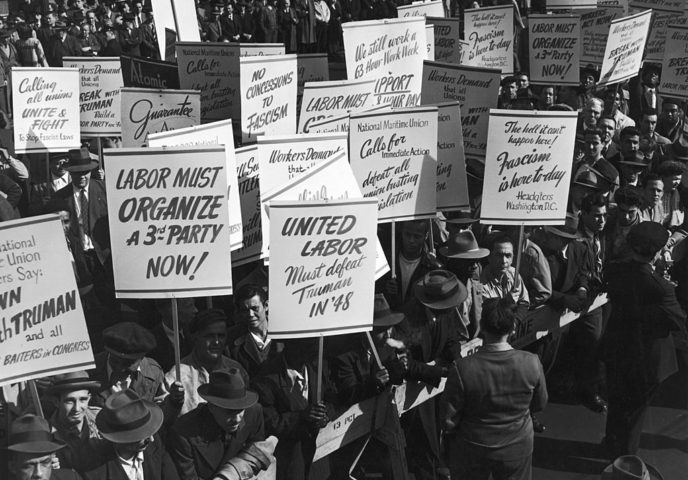
A mass demonstration in New York voices the workers’ protest against President Harry S. Truman in 1946. (FPG/Hulton Archive/Getty Images)
Yet in the end, Truman’s mediation efforts, valiant as they were, were not successful. The gap between Big Business and Big Labor was simply too wide to be easily or quickly bridged.
As a result, in November 1946, the opposition Republicans, surfing a wave of outrage against the antics of Lewis and other labor barons, won a smashing victory in the midterm elections. For the first time since 1930, the GOP had control of both chambers of Congress; indeed, it seemed that Truman himself would be a dead duck in the 1948 election.
The centerpiece of the Republican agenda for the 80th Congress, convening in January 1947, was braking, or even breaking, the power of labor.
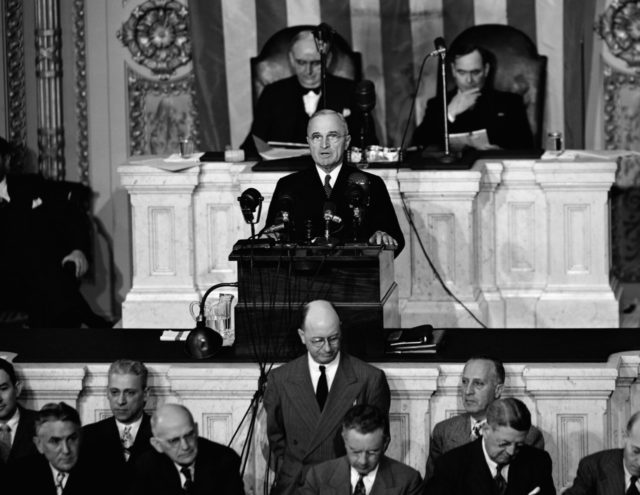
President Harry S. Truman delivers his State of the Union address before a joint session of Congress on January 6, 1947. Truman asked for mild curbs on labor and urged Congress to keep luxury taxes. (AP Photo)
Thus the Taft-Hartley Act was passed in June 1947; Truman vetoed the legislation, and his veto was overridden, with many Democrats joining in the overriding.
Yet soon after its enactment, Taft-Hartley began causing regrets. If the Wagner Act was seen as too pro-labor, Taft-Hartley was seen as too anti-labor. Seizing on this revised sentiment, and preparing for his own campaign to win a second term in the White House, Truman set about rallying labor and the party of labor, the Democrats, against the anti-labor Republicans. Prominent in the Democrat Party’s 1948 platform: “We advocate the repeal of the Taft-Hartley Act.”
Truman had gauged the shifting public sentiment correctly; the Missourian won a smashing comeback victory in 1948. In fact, not only was he victorious, but Democrats also recaptured the House and the Senate. So we can see: The “loyal opposition” in Congress had badly overplayed its hand; the country wanted the New Deal to be reformed, not repealed. (Here at Breitbart News earlier this year, I detailed Truman’s big win, considering ways in which Donald Trump could apply the same sort of anti-“loyal opposition” strategy in 2020.)
The following year, 1949, good to his word, Truman sought the repeal of Taft-Hartley. And yet he failed in his effort, largely because Southern Democrats, representing states where unions were weak, were figuring out that they could gain economically by attracting factories from the unionized North. (Taft-Hartley gave each state the option of being either a “union shop” state, or a “right to work”—that is, anti-union—state.)
Today, the “right to work” movement has spread widely; 27 states—including, amazingly enough, Michigan—have “right to work” laws on their books.
In Truman’s time, the Democrat Party was split between its Northern and Southern wings. And so, thus divided, the House of Labor started to crumble. It’s fair to say that Taft-Hartley doomed mass unionization in the U.S.
When Workers Are Weak—Labor’s Long Slide
So if we’ve seen unions when they were at their peak of optimism—critics would say arrogance—now, we can look at unions in their valley of doubt.
As we have seen, the basic idea behind labor unions is bargaining power—the power of collective bargaining.
Since the Taft-Hartley legislation of 1947, workers and their unions have always had to confront the reality that if they bargain too hard, the company can simply move to a less-expensive right-to-work state. It took a few decades before the full effect of this dynamic became obvious, but by the ’60s and ’70s, it was obvious to all.
Indeed, the percentage of private-sectors workers in unions has fallen from more than a third in the 1950s to less than seven percent today. (And free trade agreements, making it easy for companies relocate out of the U.S. altogether, have only exacerbated this trend.)
As a result, workers are in a weaker position today; they have lost their bargaining power. To be sure, there are plenty of laws on the books concerning working conditions—and plenty of trial lawyers eager to sue over some breach, real or imagined—and yet for most jobs, statutes concerning actual wages that must be paid are scant and inadequate. And that’s why there are so few strikes in the private sector; workers have learned, the hard way, that they must take what the bosses are offering.
Some Painful Numbers for Working People
Moreover, that’s why, according to the Pew Research Center, real wages (that is, adjusted for inflation) for most Americans have stagnated for the last half-century. Yes, it’s true that in many ways, the standard of living is vastly higher than it was in the 1960s, as new inventions have flooded the market, making goods both better and cheaper.
Yet still, some key variables, such as the cost of college and the cost of housing, have skyrocketed, leaving many workers today demonstrably worse off than their predecessors. And in any case, there’s nothing like a big fat paycheck.
The pro-labor Economic Policy Institute (EPI) makes a further point, focusing on the hurtful impact that ebbing bargaining power has had on workers, even as the overall economy has sailed along. According to EPI data, from 1948 to 1979, increases in wages and increases in productivity closely paralleled one another: In those three decades, productivity rose 108 percent, while compensation rose 93 percent. That wasn’t a perfect one-to-one ratio, but it was close enough. And it seemed only fair: If workers were working better, they should be sharing in the gains. And unions were there to make sure that the sharing occurred.
Yet since 1979, according to EPI, productivity and compensation have gone their separate ways: Productivity has risen 69 percent, while compensation has risen just 11 percent. To put it another way, productivity went up more than six times faster than compensation. EPI’s message is clear: In the absence of unions, the gain-sharing imperative on business was also absent.
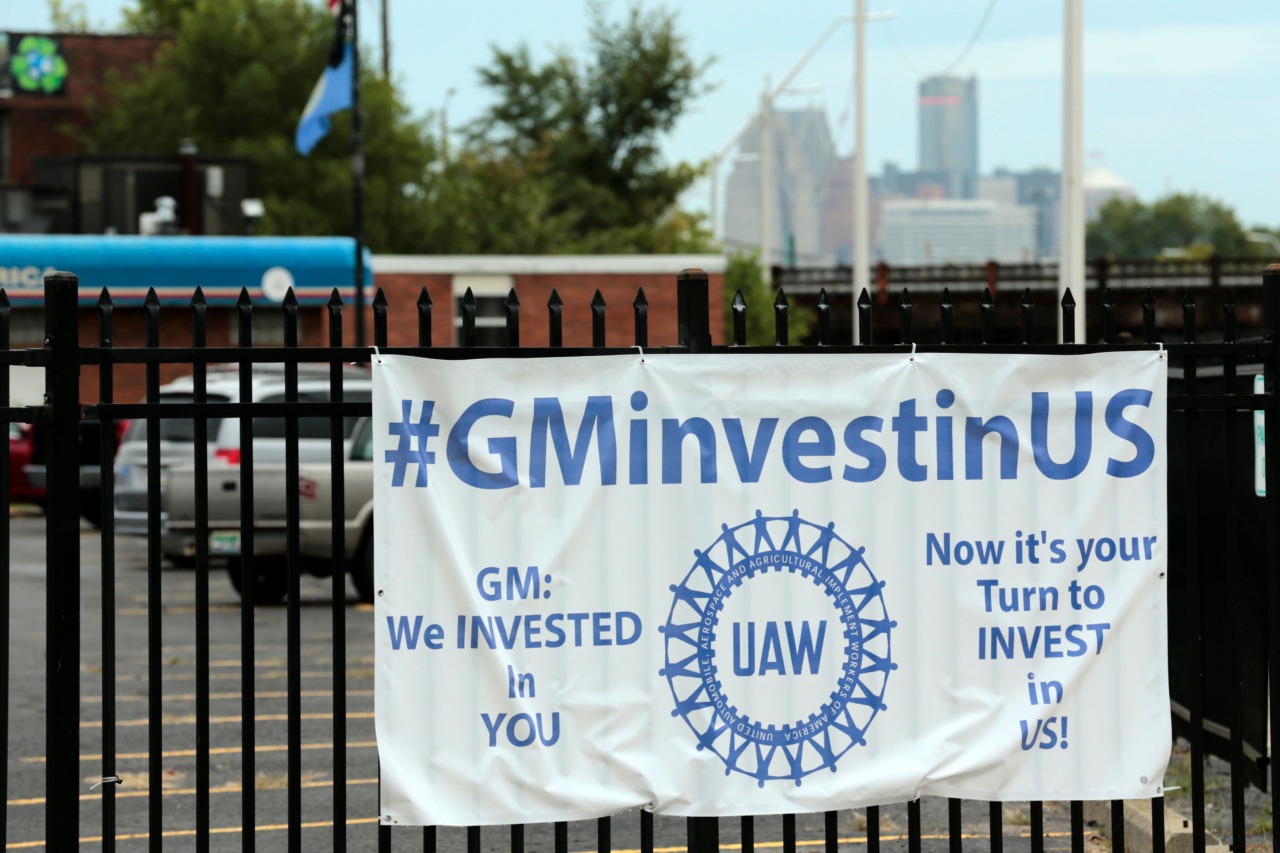
A sign hangs on the fence outside of UAW Local 22 office in Detroit, Michigan, on September 15, 2019. (JEFF KOWALSKY/AFP/Getty Images)
So where did the added value of those productivity increases go, if not to workers? Short answer: Much of the added value went to corporate investors; that’s one reason why the Dow Jones average sits above 27,000. Indeed, over the last four decades, the stock market is up more than 3,200 percent; by contrast, the federal minimum wage is up 250 percent.
Furthermore, a close look at data from the St. Louis Federal Reserve provides an even more startling look at labor’s long slide. In 1947, the year Taft-Hartley passed, compensation (defined as wages and salary accruals) accounted for 49.4 percent of GDP; that is, workers got a smidge less than half of the national output. Interestingly, the workers’ share of GDP rattled around in a narrow three-point band for the next two decades, never going below 48.8 percent and peaking, in 1969, at 51.6 percent.
Yet then came that long slide in labor incomes. Taft-Hartley obviously played a role, but so, too, did other forces, such as globalization, outsourcing, and mass immigration. By 2011, during the Obama administration, worker compensation as a percentage of GDP had fallen to 42 percent; in the last seven years, it has ticked up slightly, to 43 percent.
Hmm. From 51.6 percent of GDP in 1969 to 43 percent in 2018. Over time, ordinary folks must have noticed that fall in their share of the nation’s wealth. Indeed, now we can start to see why economic populists in decades past—Dick Gephardt in the ’80s, Ross Perot and Pat Buchanan in the ’90s—found such resonance, even if they never reached the White House. It was not until Trump that anyone could put it all together, although the anger had long been smoldering.
So again, who got those shifting 8.6 percentage points of the national wealth? They went to many places, including government, private investment, and the trade deficit. And oh yes, during the same half century, corporate profits rose from about five percent of GDP to ten percent. Yes, you read that right: Much of the change in the national share going to compensation has simply been a shift from workers to corporations—workers down more than eight points and corporate profits up five points. (Of course, it’s also true that wealth to corporations is wealth to shareholders, and many workers are shareholders, either through direct investments, or indirectly, through pension funds. But still, few workers think of themselves as investors; that’s why they call themselves workers—because they can’t rely on their capital to live, and so they have to rely, instead, on their labor.)
If we step back and consider the fate of workers’ wages over the last five decades, 1969 to 2018, we see that the change has been profound; it explains, for example, why the financiers of Manhattan are so rich and the workers of Milwaukee are so hard-pressed. After all, that decline in compensation—again, from the high of 51.6 percent down to 43 percent—amounts to a decline of 8.6 percentage points. For the U.S. economy, that’s more than one dollar in 12.
To put that 8.6-point number another way, since U.S. GDP is $21.3 trillion, 8.6 percent of that is more than $1.8 trillion. So now maybe we can better see why workers have been angry for so long: They’ve been on the losing end of that long slide—in effect, a $1.8 trillion pay cut, just in 2018.
Of course, during this long slide, most Republicans have typically cheered; they might not have even realized the income shift, but they certainly noticed the partisan shift. After all, Big Labor was once the mainstay of the Democrat Party, and so the shrinking of labor has shrunk the Democrats; the party of Thomas Jefferson and Andrew Jackson is no longer winning giant landslides in the way that the party of Franklin D. Roosevelt did in the ’30s and ’40s, or that of Lyndon Johnson did in 1964. (Of course, it’s also no longer the party of Jefferson and Jackson—or, for that matter, of FDR and LBJ.)
On the other hand, the new Democrat Party is hardly a weakling; it has won the presidency in four of the last seven elections—and won the national popular vote in six of the last seven. So while it’s true that the Democrats aren’t winning giant landslides anymore, they have proven themselves capable of winning decent-sized landslides. In 1992, for example, Bill Clinton won 370 electoral votes, and in 1996, he won 379. In 2008, Barack Obama won 365, and in 2012, he won 365. In the meantime, no Republican—including Trump—has scored more than any of those electoral-vote totals since 1988.
Moreover, in lesser elections, the Democrats are doing well enough. They boast 54 percent of seats in the House of Representatives, possess 47 percent of seats in the U.S. Senate, and hold 46 percent of governorships—and own as well nearly 100 percent of big-city mayorships.
Yet ominously for the nation, the new Democrat Party has changed: It seems that even Harry Truman-type Democrats have gone away. Truman’s old Senate seat is now held by a Republican, Josh Hawley.
Today’s Democrat Party is mostly free of the influence of industrial union halls, which were once themselves thick with American flags and military veterans.
Instead, today’s Democrats are more in the mold of either Hillary Clinton or Alexandria Ocasio-Cortez; that is, they are oriented toward de luxe financialism or relentless radicalism—and often embrace both views at the same time.
Indeed, as their center of gravity has shifted from union halls to university campuses, today’s Democrats are ever more likely to delve into exotic isms, going even further afield from lunch-bucket and kitchen-table concerns. (Although, of course, there are plenty of self-declared socialists in the Democrat Party today; so it’s hardly the case that economic concerns have disappeared, even if most Americans rightfully fear a Hugo Chavez-like policy agenda. Socialism, of course, makes Truman-style populism look pretty darn good.)
Still, the leftward ideological transformation of the Democrat Party might be helping the Republicans in some places—it’s getting easier to portray Democrats as “loony left”—and yet it also means that there will be hell to pay when the Democrats next win.

A group of UAW members at the GM/UAW auto negotiations on July 17, 2003, in Detroit, Michigan. (Bill Pugliano/Getty Images)
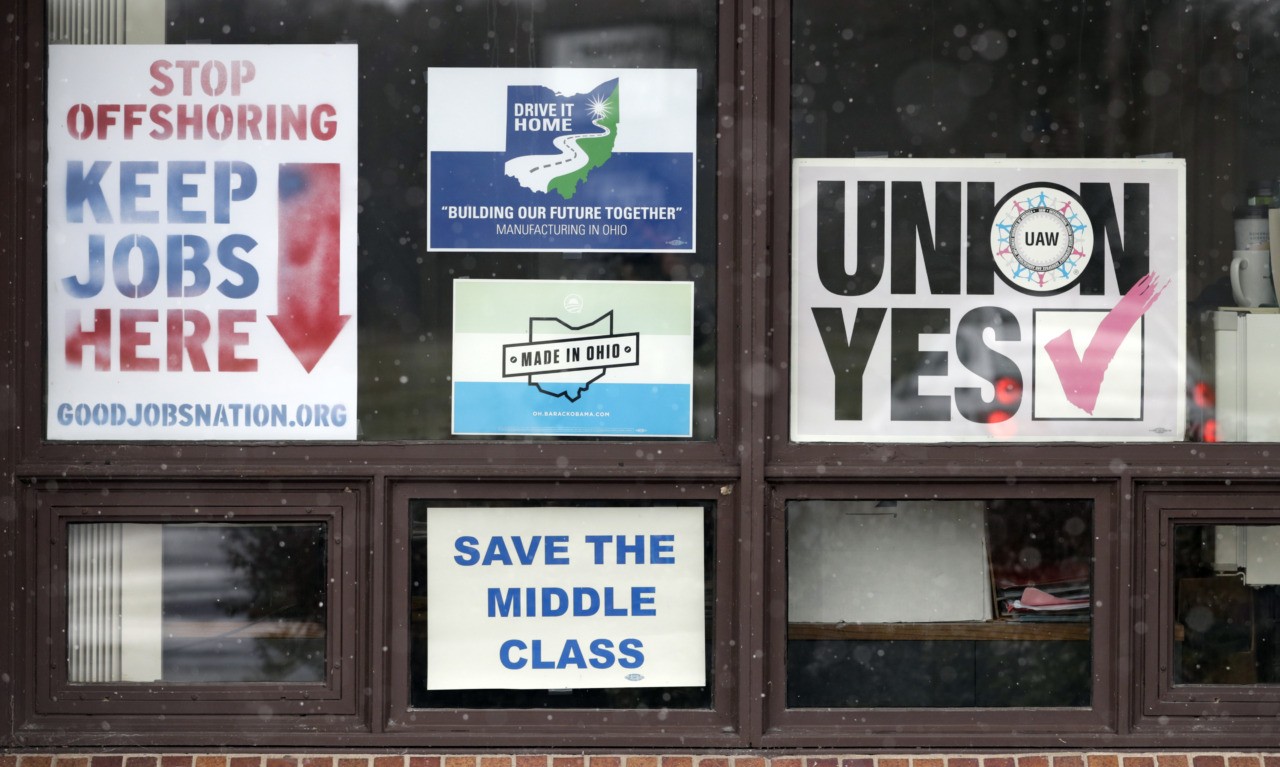
Signs hang from windows at the UAW Local 1112 union hall, in Lordstown, Ohio, in November 2018. In 2016, Lordstown’s working-class voters bucked the area’s history as a Democratic stronghold and backed Donald Trump, helping him win the White House with promises to put American workers first. (AP Photo/Tony Dejak)
The Party That Works for Workers Will Win with Workers
Of course, in the short run, there’s not much to be done about these changes. What matters more for the right is getting its own house in order, and that requires a franker understanding of who, exactly, is voting Republican these days.
To that end, more Republicans might take a close look at the 2014 manifesto that helped inspire Donald Trump to run for president: Rick Santorum’s Blue Collar Conservatives: Recommitting to an America That Works.
In addition, majority-minded Republicans might study The Republican Workers Party: How the Trump Victory Drove Everyone Crazy, and Why It Was Just What We Needed, published last year by F. H. Buckley. That phrase, Republican Workers Party, is a keeper.

President Donald Trump speaks to auto workers at the American Center for Mobility on March 15, 2017, in Ypsilanti, Michigan. Trump discussed his priorities of improving conditions to bolster the manufacturing industry and reduce the outsourcing of American jobs. (Bill Pugliano/Getty Images)
In this vein of Main Street Republicanism, it was heartening to see the September 17 headline in Politico: “White House intervenes in General Motors strike: The effort would effectively put the White House on the side of the United Auto Workers.” (Yes, the formal UAW structure is still strongly aligned with the Democrats, but as Breitbart News has noted, in 2017 and again in 2019, the actual auto workers are now mostly Republican—although, of course, it’s always possible to make them more Republican.)
Yet of course, if the Democrats, starting with Sanders and Warren, choose, once again, to worry about auto workers and the working class in general—and if they can demonstrate that they’re truly sincere and not just using workers for props—well, who knows what will happen in 2020, and beyond.
In addition, over the long run, if we’re feeling philosophical, we might give ourselves time to think about how America would be different today if labor unions hadn’t been so profoundly sundered by Taft-Hartley, way back in the fateful decade of the ’40s.
That is, what if the Democrats were still following practical-minded middle-of-the-roaders, such as Harry Truman? As we have seen, back in the ’40s, Truman did not succeed in saving the unions from the start of their long slide—but at least he gave it his best shot.
Harry Truman, Meet Your Senatorial Successor, Josh Hawley
And as we think back on Truman, we might also think ahead. We might look, for instance, to the man now sitting in Truman’s Senate seat, Josh Hawley. Just on September 18, in an exclusive interview with Breitbart News, Hawley outlined his vision of standing up for ordinary folks: “If the conservative movement wants to have a future, it’s going to have to commit itself to being the movement of working people. If we do that, if conservatives do that, if there’s a core group that will do that, then the rest of D.C., the lobbyists, they will follow along. It’s going to have to be people-driven change.”
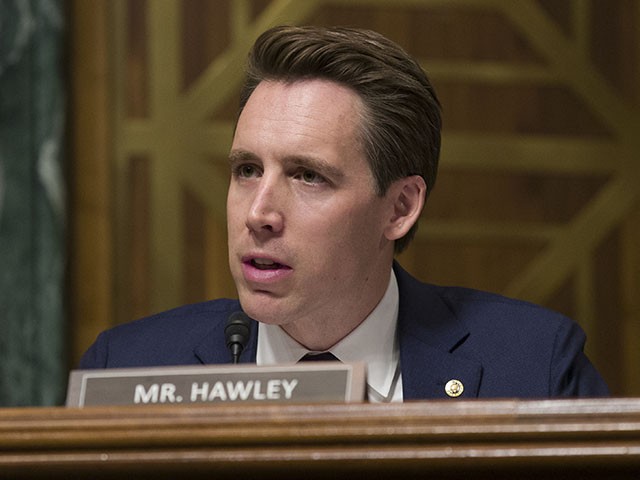
Sen. Josh Hawley (R-MO) speaks during Senate Judiciary Committee hearing on March 6, 2019, in Washington, DC. (Alex Brandon/AP Photo)
So what, exactly, does Hawley have in mind? How, precisely, is he going to seek to raise the standard of living in Missouri—and everywhere else? Hawley hasn’t yet fleshed out the details, but hey, let’s give him space; he’s only been in the Senate for nine months, and he’s spent most of that time on a worthy mission, namely, taking on Big Tech—and on that subject, he’s provided plenty of details.
Yet even so, he had more to say to Breitbart News, and what he said is encouraging:
We have to stay focused on the issues that actually matter to real people and have to challenge the leadership class. So, as the Democrats turn towards socialism, is that a problem? Yeah, it is, but it just goes to show you that they have no idea how to respond to the needs of working people. We can’t just reject their crazy ideas. We also have to push forward with an agenda that actually benefits what I call the “American middle,” which is the middle of our society, people that really sustain our society. So it’s going to be a pro-worker agenda, it has to get wages up, we have to get manufacturing going again, we have to get healthcare costs down, to get folks new opportunities to get skills and jobs training, break up the monopoly of higher education, and take on the monopolists in the economy and their sweetheart deals with government.
Hawley has his own ideas, and yet we can recognize some Trumanesque themes.
And Truman, let’s not forget, spent nearly eight years in the White House.



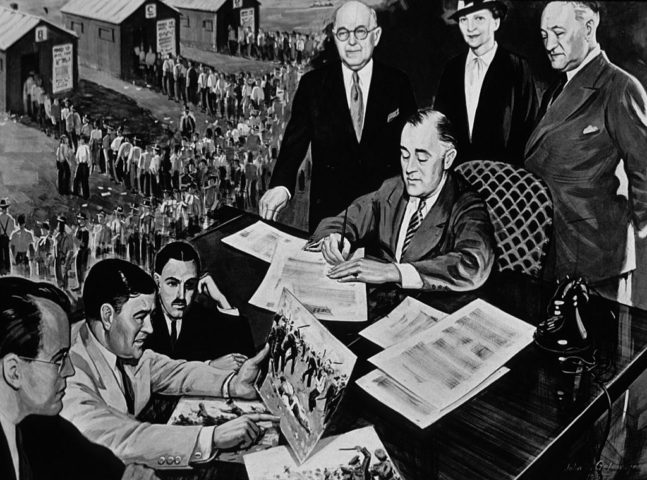
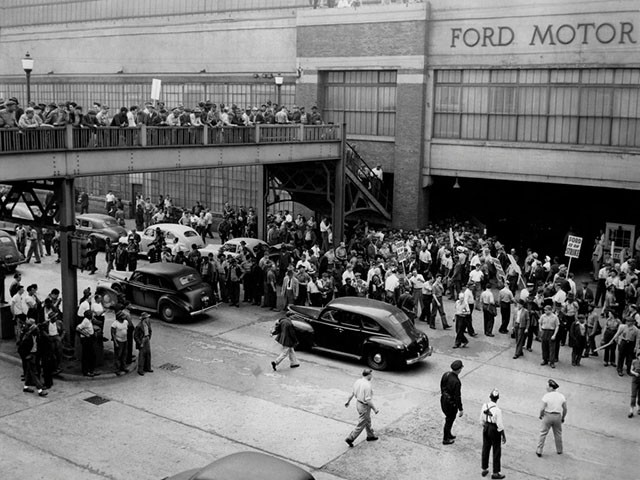

Comments are closed.